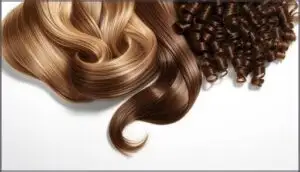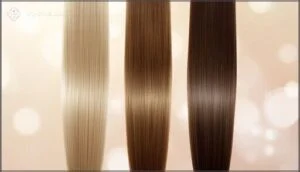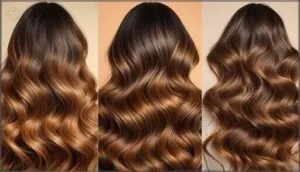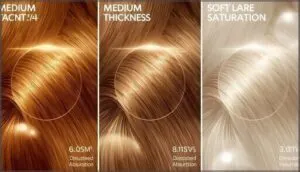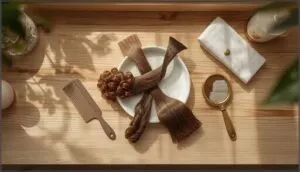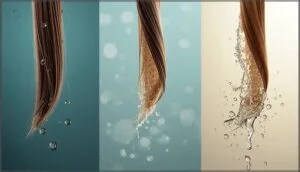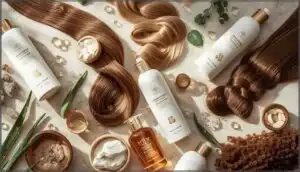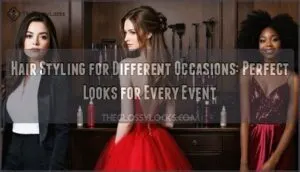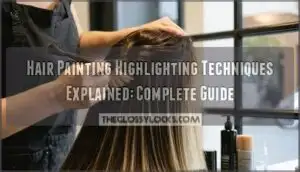This site is supported by our readers. We may earn a commission, at no cost to you, if you purchase through links.
Your hair falls somewhere on a spectrum that includes everything from pin-straight strands to tight coils—but most people can’t accurately identify where they land. That’s because hair texture isn’t just about whether your hair is curly or straight. It’s a combination of your curl pattern, strand diameter, and porosity working together to determine how your hair behaves, what products it needs, and which styling techniques actually work.
Understanding these distinctions changes everything about your hair care routine. When you know your specific texture type, you stop wasting money on products that sit heavily on your strands or disappear without effect. You’ll finally understand why your friend’s holy-grail conditioner does nothing for you, and why that viral styling hack left your hair looking flat instead of voluminous.
Table Of Contents
- Key Takeaways
- What is Hair Texture?
- How Hair Types Are Classified
- Straight Hair Types Explained
- Wavy Hair Types Explained
- Curly Hair Types Explained
- Coily and Kinky Hair Types
- Hair Texture Subcategories
- How to Determine Your Hair Texture
- Hair Porosity and Its Impact
- Caring for Different Hair Textures
- Frequently Asked Questions (FAQs)
- Conclusion
Key Takeaways
- Hair texture is determined by three independent factors working together—curl pattern (straight to coily), strand diameter (fine to coarse), and porosity (how your hair absorbs and retains moisture)—which is why understanding all three explains why products that work for others might fail you.
- The hair typing system runs from Type 1 (straight) through Type 4 (coily) with A, B, and C subcategories indicating texture intensity, but your individual strands can simultaneously fall into different categories across your scalp due to genetic variations in follicle shape.
- Porosity matters as much as curl pattern because it controls product absorption rates—low porosity hair absorbs less than 25% of moisture in five minutes while high porosity absorbs over 90% but loses it quickly, directly impacting which treatments actually work.
- Matching your hair care routine to your specific texture combination stops you from wasting money on products that sit heavily on your strands or disappear without effect, since each texture type requires different formulas, washing frequencies, and styling techniques to thrive.
What is Hair Texture?
Hair texture is the natural shape and pattern your hair forms as it grows from your scalp. It’s different from things like thickness or density, and it plays a big role in how you care for and style your hair.
Understanding what texture really means starts with breaking down a few key ideas that shape how your hair behaves.
Definition of Hair Texture
Your hair’s physical personality comes down to texture—the strand diameter and fiber thickness of each individual hair fiber. Understanding hair textures means looking at hair morphology, which includes tactile assessment and sometimes microscopic analysis to measure how thick or thin your strands really are.
Different hair texture types include:
- Fine hair – less than 50 microns in diameter
- Medium hair – between 60-80 microns thick
- Coarse hair – exceeds 80 microns in diameter
These hair texture characteristics determine how your hair behaves and what it needs to thrive; in fact, genetic variations greatly influence hair texture.
How Texture Differs From Hair Type
While texture measures strand diameter (how thick each fiber is), hair type refers to your curl pattern—straight, wavy, curly, or coily. These are independent traits determined by different genetic factors: follicle shape controls your curl pattern, while strand diameter comes from cuticle layer density. You can have fine, curly hair or coarse, straight hair.
Changing texture happens, but your curl pattern stays fixed. A key factor is hair’s ability to absorb and retain moisture.
Factors Determining Hair Texture
Your hair texture depends on several interacting factors:
- Genetic influence: Over 75 variants control follicle shape and protein structure, determining whether you have straight, wavy, curly, or coily hair type
- Hormonal shifts: Puberty, pregnancy, and menopause can alter hair thickness and strand diameter
- Age-related changes: Follicles shrink over time, affecting hair porosity and texture
Follicle shape produces your curl pattern, while protein structure gives strands their strength and flexibility.
How Hair Types Are Classified
You’ve probably noticed that hair comes in all kinds of textures, from pin-straight to tightly coiled. The beauty world has actually created a straightforward system to make sense of all this variety.
Let’s break down how experts classify hair types and what makes each one unique.
The Four Main Hair Types
Your strands fall into one of four major categories based on their natural curl pattern. Straight hair (Type 1) lies flat with no waves. Wavy hair (Type 2) forms gentle S-curves. Curly hair (Type 3) creates defined spirals. Coily hair (Type 4) coils tightly with significant shrinkage.
Each type has distinct characteristics affecting care differences, styling challenges, and global prevalence across populations.
The Role of Hair Follicle Shape
Your hair follicle’s shape—whether round or oval—determines your texture before each strand leaves your scalp. Round follicles produce straight hair, while curved follicles create waves and curls. This shape influences hair shaft structure, growth angle, and strand thickness.
Follicle diameter impacts volume, and follicle asymmetry intensifies curl tightness. Genetics control these variations through approximately 75 variants affecting follicle shape, making texture fundamentally biological.
Global Distribution of Hair Types
Across continents, genetic factors and climatic influence shape hair texture variations in striking patterns. Over 80% of Asia’s population has straight hair, while coily types dominate Africa. European hair type categories blend straight and wavy, and North America shows diverse hair texture due to ethnic prevalence.
Cultural practices reflect these different hair texture types, with global statistics revealing that 86% worldwide have textured hair—wavy, curly, or coily.
Global statistics show that 86% of the world’s population has textured hair—wavy, curly, or coily
Straight Hair Types Explained
Straight hair falls into Type 1, which means it grows without any natural curl or wave pattern. Even within this category, you’ll find real differences based on thickness and body.
Let’s break down the three straight hair subtypes so you can pinpoint exactly where your hair fits.
Type 1A (Ultra-Straight, Fine)
You’re looking at the rarest texture out there—Type 1A hair, accounting for less than 2% of the population. This ultra-straight, fine hair texture features the thinnest strands, giving it a sleek, glass-like appearance but also making it prone to breakage.
Oil production travels fast down the shaft, so you’ll notice greasiness quickly. Volume styling becomes tricky, and breakage prevention requires gentle handling and lightweight fine haircare products.
Type 1B (Straight, Medium)
You’re sitting in the sweet spot—Type 1B hair, the most common straight hair type, accounting for roughly 28% to 32% of straight-haired individuals. Your strands measure medium thickness with a barely noticeable wave from mid-length down, giving you more styling versatility than 1A.
1B oiliness happens faster due to efficient sebum migration, so you’ll notice greasiness within a day. Product buildup sneaks up 16% more often on your strands, making lightweight formulas essential for maintaining 1B volume tips without weighing down your roots.
Type 1C (Straight, Coarse)
You’ve got Type 1C hair if your strands feel thick to the touch with subtle bends that tease the line between straight and wavy. This coarse hair texture holds more volume than 1B but fights frizz constantly—humidity turns those slight S-bends into flyaways.
Your roots stay flat while mid-lengths poof, creating styling challenges that require anti-frizz treatments and lightweight hydrating products balanced for oily scalps with dry ends.
Wavy Hair Types Explained
Wavy hair sits right in the middle, between straight and curly. It forms a gentle S-shape that can vary from barely-there bends to more pronounced waves.
Let’s break down the three subcategories of Type 2 hair and what makes each one unique.
Type 2A (Loose Waves)
Type 2A hair has the gentlest waves in the wavy hair category, starting a few inches from your roots. Your hair texture features fine strands prone to oiliness and product buildup that can flatten wave definition.
You’ll notice your 2A hair type shows medium to high porosity, making porosity management essential. Focus on lightweight styling techniques and volumizing products to boost your natural hair styling without weighing down those loose waves.
Type 2B (Defined S Waves)
When your waves form clearer “S” shapes from mid-length down, you’ve got 2B hair type. Your wavy hair shows more defined curl pattern and volume than 2A, but frizz control becomes your main challenge.
Focus on hydration needs through lightweight leave-ins and anti-frizz serums for hair styling success. About 44% of North American women share this hair texture, making product selection and 2B styling advice widely available.
Type 2C (Thick, Wavy Hair)
Your waves jump in with bold “S” shapes right from the roots when you have 2C hair type. This wavy hair texture feels thick and coarse, sitting perfectly between waves and curls.
You’ll notice your strands resist damage better than finer textures, but frizz control and tangles come with the territory. Focus your hair styling routine on moisture-rich products that define waves while taming flyaways.
Curly Hair Types Explained
Curly hair, or Type 3, is where things get interesting. Your curls form defined spirals that range from loose and bouncy to tight corkscrews, and each variation comes with its own personality and care needs.
Let’s break down the three subcategories so you can figure out exactly where your curls fall.
Type 3A (Loose Curls)
Your 3A hair type showcases those beautiful loose, springy curls—think sidewalk chalk-sized ringlets that bounce with life. The curl pattern forms distinct S-shaped spirals that hold their shape beautifully, creating natural volume at the ends while your roots stay a bit flatter.
Understanding your 3A definition helps you choose the right products and styling techniques:
- Strand structure: Fine to medium strands create lightweight, bouncy curls with less shrinkage than tighter curly hair types
- Porosity levels: About 42% of you have medium porosity, while 36% experience low porosity and 22% deal with high porosity characteristics
- Styling 3A curls: Over 60% wash 2–3 times weekly, and 87% detangle while wet and conditioned to minimize frizz
- 3A maintenance essentials: Roughly 74% prefer lightweight, water-based creams and sulfate-free shampoos that won’t weigh down your hair texture
- Global 3A prevalence: Curly hair accounts for about 12% of textured hair worldwide, appearing frequently in diverse, multicultural communities
Type 3B (Springy Curls)
When your curls spiral tighter, you’ve entered 3B hair type territory. Your curl pattern wraps around a Sharpie-sized diameter, creating well-defined springlets from roots to ends. This 3B definition describes medium-to-coarse strands that pack serious volume and bounce.
| Feature | Characteristic | Care Focus |
|---|---|---|
| Porosity factors | High absorption, low retention | Deep conditioning weekly |
| Curl elasticity | Strong spring-back ability | LOC/LCO methods |
| Common issues | Dryness, frizz, shrinkage | Sulfate-free products |
Your maintenance tips start with understanding porosity factors—3B hair drinks up moisture but struggles holding onto it, which explains the dryness. However, curl elasticity gives your hair texture considerable resilience when you’re caring for it properly.
Type 3C (Tight Corkscrew Curls)
Pencil-thick corkscrews define the tightest curls in Type 3 territory. Your 3C hair type shows tightly coiled spirals that pack together densely, creating impressive volume despite significant shrinkage challenges.
This hair texture predominates in African and Afro-Caribbean communities globally.
- Moisture retention demands sulfate-free cleansers and weekly deep conditioning to combat natural dryness
- Styling techniques work best on wet hair using the LOC method for curl definition
- Product selection requires rich creams and oils, since your curl pattern prevents natural oils from traveling down strands
Coily and Kinky Hair Types
Type 4 hair is the most tightly coiled of all the hair types, featuring dense curls that shrink considerably when dry. This hair type is largely found among people of African descent and requires specific care to maintain moisture and prevent breakage.
Let’s break down the three subcategories of coily hair and what makes each one unique.
Type 4A (Soft Coils)
Think of 4A hair as soft, springy coils with an S-shaped curl pattern. This hair type grows up and out, creating volume. Your coil diameter measures roughly the width of a crochet needle, and shrinkage can hit 70% when dry. Moisture needs are high—over 66% report dryness as their top concern. Detangling tips include using water-based leave-ins weekly. Product dissatisfaction often stems from poor slip and fading hydration.
| 4A Hair Characteristic | What You’ll Notice |
|---|---|
| Curl Pattern | Defined S-shaped coils |
| Coil Diameter | 0.5–1 cm (crochet needle width) |
| Shrinkage | Up to 70% when dry |
| Moisture Needs | High; dryness reported by 66% |
| Common Challenge | Breakage 2.2x higher than other types |
Type 4B (Z-Shaped Coils)
Your curl pattern here forms a sharp zigzag, not smooth coils. Type 4B hair features Z-shaped bends that shrink 50–75% and clump like cotton candy.
Coily hair with this texture struggles to hold moisture—open cuticles absorb well but lose hydration fast. Protective practices like scarves and puffs reduce breakage, which runs 70% higher than some other types.
Cultural significance? 4B definition celebrates African heritage globally.
Type 4C (Tight, Dense Coils)
Your tightest coils live here—4C hair type shrinks up to 90% of its actual length, making growth seem invisible. These densely packed zigzags form delicate strands prone to breakage, demanding moisture retention through oils and leave-ins.
Protective styles like twists shield fragile coily hair from manipulation. Type 4 hair’s styling challenges require patience, but embracing coiled hair’s natural volume celebrates its powerful beauty and resilience.
Hair Texture Subcategories
Beyond the curl pattern categories we’ve covered, there’s another layer to understanding your hair: texture thickness. Your individual strands can be fine, medium, or thick, and this makes a real difference in how your hair behaves and what it needs.
Let’s break down these three texture subcategories so you can figure out exactly where your hair fits.
Fine Hair Characteristics
Fine hair texture is defined by strand diameter, not density. Your hair strands measure less than 60 micrometers across, making them delicate and prone to hair breakage.
This hair thickness vs density distinction matters because fine hair often struggles with volume challenges and gets greasy faster as oils coat thinner strands quickly.
Product buildup weighs down your hair, so lightweight formulas work best.
Medium Hair Characteristics
Medium hair texture sits right in that sweet spot between fine and coarse. Your hair strands measure 0.06 to 0.08 millimeters in strand diameter, giving you natural styling versatility most people envy.
Here’s what defines your medium hair texture:
- Density factors: You’ve got roughly 2,200 to 2,400 strands per square inch
- Damage resistance: Your hair type withstands about 3,000 styling manipulations before breaking
- Cuticle layers: 8 to 10 protective layers balance strength with flexibility
- Product absorption: Absorbs 18-22% by weight without buildup
- Hair thickness vs density: Balanced structure accommodates most products and styles
Your medium hair strand diameter means you won’t see much scalp visibility, and your hair holds heat-styling shapes 20% longer than finer textures.
Thick/Coarse Hair Characteristics
If your hair strands measure over 0.08 millimeters in strand diameter, you’ve got thick hair texture. This coarse hair fibre type shows up in about 31% of people globally, with ethnic prevalence highest in African populations at 40.7%.
Your hair density means stronger strands, but moisture retention becomes your biggest styling challenge. That’s why protein treatments and oil-based products matter so much for your hair texture.
How to Determine Your Hair Texture
Figuring out your hair texture doesn’t require a lab coat or fancy equipment. You can identify your type using simple at-home methods that take just a few minutes.
Let’s walk through the most reliable ways to determine exactly what you’re working with.
Visual and Touch Tests
You can identify your hair texture through two simple methods. Visual accuracy ranges from 71% to 85% when you examine your strands carefully. Tactile analysis helps you feel differences between hair types—fine strands feel delicate, while coarse hair feels thicker and stronger.
- Straight hair shows circular cross-sections, while curly hair appears more elliptical
- Test limitations include up to 29% error in mixed hair types
- Population data reveals quantitative measures like friction coefficients vary considerably across textures
The Role of Curl Pattern Charts
Once you’ve checked your strands by sight and touch, curl pattern charts help you pinpoint your exact hair type. These hair typing systems classify textures from 1 to 4, with subcategories A, B, and C describing curl tightness. Digital chart tools now offer AI-based predictions with 80-90% accuracy. Keep in mind chart limitations—about one-third of strands show mixed patterns from root to tip.
| Chart Feature | How It Helps |
|---|---|
| Type classification (1-4) | Identifies straight, wavy, curly, or coily hair |
| Subcategories (A-C) | Defines curl tightness and diameter |
| Curl pattern definitions | Guides product selection for tailored styling |
| Digital analysis | Improves accuracy of hair texture identification |
Identifying Mixed Hair Types
Your hair mightn’t fit neatly into one category—that’s mixed hair genetics at play. When ethnic texture variations blend, you’ll see multiple hair types on one head. Hair follicle shape varies across your scalp, creating hybrid hair care needs. Identifying hair types categories becomes trickier, but spotting these variations helps you choose products that work for every section.
Check for different curl pattern analysis results from roots to ends.
Hair Porosity and Its Impact
Hair porosity is just as important as texture regarding understanding how your hair behaves. It determines how easily your strands absorb and hold onto moisture, which affects everything from product choice to styling results.
Here’s what you need to know about the different porosity levels and how they impact your hair care routine.
Low, Medium, and High Porosity
Your hair’s porosity—how well your strands absorb and hold water—directly shapes your entire hair care routine. Think of it this way: porosity is determined by your cuticle structure, which acts like a gatekeeper for moisture levels.
- Low porosity hair has tightly sealed cuticles that resist water, making it harder to hydrate but easier to maintain once moisturized
- Medium porosity hair strikes the perfect balance, absorbing and retaining moisture without much fuss
- High porosity hair has raised or damaged cuticles from chemical treatments or heat, quickly soaking up water but losing it just as fast
Understanding your porosity through simple porosity testing helps you choose the right products for cuticle care and porosity repair.
Porosity and Product Absorption
Porosity measurement reveals exactly why your hair reacts differently to the same products as your friend’s. Hair porosity determines product penetration rates through your cuticle structure—and the differences are dramatic.
Low porosity hair absorbs less than 25% of moisture within five minutes, often causing product buildup on the surface. Medium porosity achieves 75% absorption in four minutes, while high porosity hair soaks up over 90% within two minutes but loses it quickly.
These absorption rates directly affect treatment efficacy, explaining why deep conditioners work wonders for porous hair but weigh down tightly-sealed strands.
Caring for Different Hair Textures
Once you know your hair texture, the real work begins—choosing the right products and techniques to keep it healthy and looking its best. Each hair type has unique needs, from the products that work best to the styling methods that accentuate your natural texture.
Let’s break down what works for different textures, along with practical tips for daily care and long-term maintenance.
Product Recommendations by Texture
Choosing the right hair products starts with matching formulas to your texture. Fine hair thrives with lightweight volumizing shampoos, while medium hair benefits from multi-action leave-ins that lock in moisture for up to 72 hours. Coarse hair needs sulfate-free moisturizing formulas and weekly deep conditioning masks.
For curly hair, brands like Shea Moisture and Cantu deliver the hydration you need.
Understanding your hair porosity helps you select hair treatment products that actually work.
Styling Tips for Each Hair Type
Your hair texture dictates which hair styling techniques work best. Straight hair styling benefits from layered cuts that boost volume by 45%, while wavy hair techniques like accentuate natural waves in 48% of cases. Curly hair routines thrive with sulfate-free products increasing springiness by 49%. For coily hair methods, wide-tooth combs reduce breakage by 36%, and fine hair volumizing works best with textured bobs.
Protective Styling and Maintenance
Think of protective styling as giving your strands a vacation from daily manipulation. Braids, twists, and updos boost moisture retention and support hair health by reducing breakage up to 40%. You’ll see impressive style longevity—most last 4 to 8 weeks with proper hair maintenance.
Just watch for tension risks that can damage your scalp health, and remember the cultural significance these techniques carry.
Maintaining Scalp and Hair Health
Your scalp microbiome balance directly influences hair health—and you’ve got more control than you think. Here’s your foundation for a strong hair care routine:
- Wash 5-6 times weekly to reduce flaking and itchiness (washing frequency effects matter)
- Eat antioxidant-rich foods for nutritional hair health and stronger strands
- Match products to your hair texture and scalp condition prevalence needs
- Monitor hair moisture levels based on your porosity
Frequently Asked Questions (FAQs)
Can hair texture change over time naturally?
Yes, your hair texture can shift naturally. Genetic influence, hormonal shifts, environmental impact, and the growth cycle all play roles.
Hair characteristics evolve with aging, and experimental findings confirm these hair structure changes happen.
How does humidity affect different hair textures?
When moisture-laden air meets your strands, hydrogen bonds form between water molecules and hair proteins.
High porosity curls absorb more humidity, causing texture swelling and hair frizz, while low porosity types resist moisture, staying smoother.
What role does genetics play in texture?
Your hair texture is written in your DNA. Curl dominance means you’ll likely pass wavy or coily locks to your kids.
TCHH gene and EDAR variants, along with ethnic variations, determine your natural texture pattern.
Does hair texture vary across the scalp?
Different hair textures can exist across your scalp due to follicle size variation and regional porosity differences. Genetic texture mapping shows the vertex, temporal, and occipital zones often display distinct characteristics even within one head.
How do chemical treatments alter hair texture?
Chemical changes aren’t just surface-level. Relaxers, perms, and bleach disrupt your hair’s internal bonds, leading to bond disruption, increased dye porosity, bleach brittleness, and perming effects that cause hair breakage and reduce elasticity permanently.
Conclusion
Your hair has been telling you what it needs all along—you just needed the language to understand it. Now that you’ve explored hair texture types explained through curl patterns, strand thickness, and porosity levels, you can finally match products and techniques to your specific needs.
Stop guessing at what might work. Start treating your hair like the unique combination it is, and watch how it transforms when you give it exactly what it’s been asking for.
- https://en.wikipedia.org/wiki/Andre_Walker_Hair_Typing_System
- https://www.lorealparisusa.com/beauty-magazine/hair-care/all-hair-types/hair-textures
- https://olaplex.com/blogs/news/how-to-determine-hair-type-and-texture
- https://mybabyhair.com/understanding-hair-types-across-ethnicities-differences-commonalities-and-universal-needs/
- https://www.onychair.com/different-types-of-hair-textures-natural-hair-types/


